Are You Able to Dispose of Food Waste in the Toilet?
Are You Able to Dispose of Food Waste in the Toilet?
Blog Article
The content in the next paragraphs on the subject of What Can Happen If You Flush Food Down the Toilet? is amazingly compelling. You should check this stuff out.

Introduction
Lots of people are often confronted with the dilemma of what to do with food waste, especially when it concerns leftovers or scraps. One typical concern that occurs is whether it's okay to flush food down the commode. In this post, we'll delve into the reasons that individuals might consider purging food, the effects of doing so, and different approaches for appropriate disposal.
Reasons people could consider purging food
Absence of awareness
Some people might not recognize the prospective damage triggered by flushing food down the toilet. They might mistakenly believe that it's a harmless practice.
Ease
Purging food down the toilet might appear like a fast and easy solution to dealing with unwanted scraps, particularly when there's no nearby garbage can readily available.
Negligence
In some cases, people might simply select to flush food out of large laziness, without taking into consideration the repercussions of their activities.
Consequences of flushing food down the bathroom
Ecological influence
Food waste that ends up in rivers can contribute to pollution and harm water communities. Additionally, the water used to flush food can stress water sources.
Pipes issues
Purging food can bring about stopped up pipes and drains, triggering pricey plumbing repair work and inconveniences.
Types of food that must not be purged
Fibrous foods
Foods with coarse textures such as celery or corn husks can get entangled in pipes and cause clogs.
Starchy foods
Starchy foods like pasta and rice can soak up water and swell, bring about obstructions in pipelines.
Oils and fats
Greasy foods like bacon or cooking oils should never ever be flushed down the commode as they can solidify and cause clogs.
Proper disposal techniques for food waste
Making use of a garbage disposal
For homes equipped with garbage disposals, food scraps can be ground up and purged via the plumbing system. Nonetheless, not all foods are suitable for disposal in this manner.
Recycling
Particular food packaging products can be reused, lowering waste and lessening ecological impact.
Composting
Composting is an environment-friendly way to deal with food waste. Organic products can be composted and utilized to enrich dirt for gardening.
The value of proper waste monitoring
Lowering environmental injury
Appropriate waste monitoring methods, such as composting and recycling, help decrease pollution and maintain natural resources for future generations.
Protecting pipes systems
By preventing the technique of flushing food down the bathroom, home owners can protect against expensive plumbing fixings and keep the stability of their plumbing systems.
Conclusion
To conclude, while it may be tempting to purge food down the commode for convenience, it is very important to recognize the prospective consequences of this activity. By embracing proper waste monitoring methods and getting rid of food waste responsibly, people can contribute to healthier plumbing systems and a cleaner setting for all.
FLUSH FOOD DOWN THE TOILET?
FLUSHING FOOD CAN CAUSE BLOCKED DRAINS IN YOUR HOME
All of the plumbing fixtures in your home are connected to the same sewer pipe outside of your home. This outdoor sewer pipe is responsible for transporting all the wastewater from your home to the Council sewer mains. Even small pieces of food that go down the kitchen sink can cause problems for your sewer. It should therefore be obvious that flushing larger bits of food, such as meat, risks a clog in either the toilet itself or the sewer pipes. Flushing greasy food is even more problematic because oil coagulates when it cools, coating the interior lining of your pipes.
THE TOILET IS NOT A BIN
Food isn’t the only thing that people shouldn’t be flushing down the toilet. People use the toilet to dispose of all kinds of things such as tampons, makeup wipes, dental floss, kitty litter and even underwear. Water goes to great lengths to educate residents about the high costs and stress placed on wastewater treatment systems simply from people flushing the wrong stuff down the toilet. It costs taxpayers millions of dollars each year, and homeowners thousands in blocked drain repairs.
FLUSHING FOOD IS A WASTE OF WATER
Flushing food is a waste of our most precious resource - water. In June this year Level 1 water restrictions were introduced to protect water supply from drought conditions. Much of New South Wales continues to be affected by prolonged drought with recent figures revealing up to 97 per cent of the state remains in drought. Depending on whether you have a single or dual flush toilet, every single flush uses between five and 11 litres of water. In the current climate this is a huge amount of water to be wasting on flushing food that should be placed in the bin (or better yet, the compost).
https://www.jabplumbingsolutions.com.au/blog/can-you-flush-food-down-the-toilet

As a passionate person who reads about Flushing Food Down the Toilet?, I thought sharing that post was a great idea. Do you know another individual who is fascinated with the subject? Do not hesitate to promote it. Thanks so much for going through it.
Visit My Site Report this page